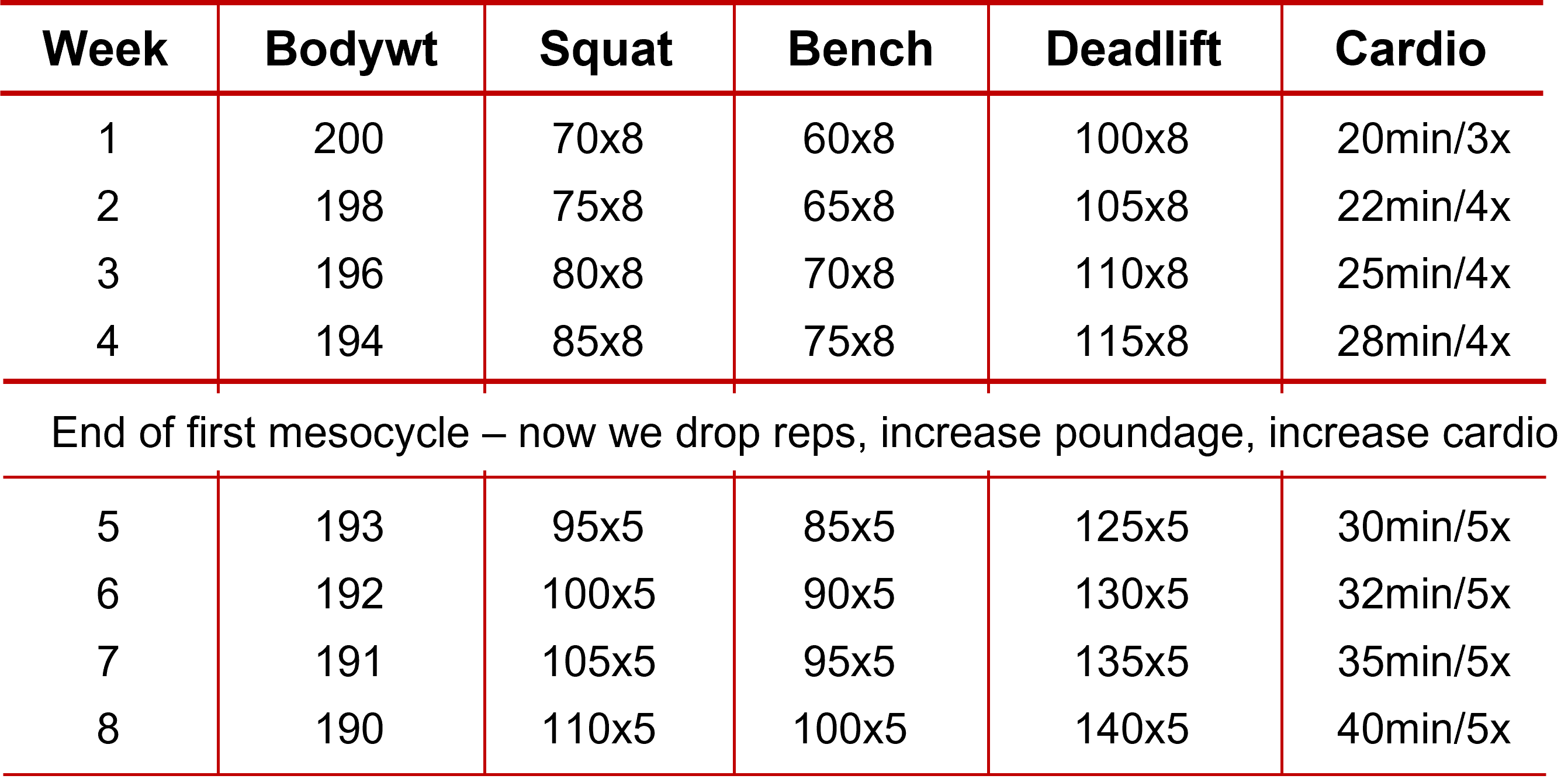
All Purposefully Primitive resistance trainers use periodization, pre-planning, in order to morph from current physical condition into vastly improved physical condition. The use of a timeline allows us to convert small weekly gains into huge cumulative gains. Monthly mesocycles are broken into weekly microcycles.
Empirical experience has shown that four weeks to six weeks is about the right amount of time to work a particular progress vein. Less that four weeks and the individual could be accused of not giving the selected mode or method enough time to bear fruit. Staying with a non-productive mode for longer that 4-6 weeks is counter-productive and betrays an unhealthy allegiance to a system gone dry.
We construct a periodization cycle that further illustrates our methods. Periodization principles are perfect for resistance training; cardiovascular training and nutrition can also be periodized. The Purposeful Primitive always has a plan. "Cast a Cycle," create a game plan, establish weekly goals in the interrelated elements. For example, weight training, cardio, bodyweight and nutrition can be cycled. The first order of business is to establish realistic goals. Reverse engineer the process, move backwards from the goal to the beginning and create weekly mini-goals. Hit the micro goals and the meso goal takes care of itself.

Let us construct another periodized game plan, this one for the average person of average capacities and capabilities. We will layer on a half dozen progress benchmarks and use an 8 week cycle. In this case we will assume the person would like to lose 10 pounds and add a few pounds of muscle during the process. Experience has shown that a stone beginner (less than six months training) can lose fate while simultaneously growing stronger. Those new to the progressive resistance experience will find that new muscle is easily built, even in the face of consistent weekly body weight loss.
The hypothetical individual is male: He stands 5'10", weighs 200 with 20% body fat and would like to shed 10 pounds in eight weeks - a realistic goal. Because he is a total beginner, with limited time to weight train, I would select a Cassidy-inspired twice a week training regimen concentrates on doing three powerlifts to exclusion. The three lifts are performed in two 30 minute weekly sessions. We project and track five inter-related categories: bodyweight, bench, squat, deadlift and cardio.
Beginners should warm up with 50% of the day's top poundage on the 1st warm up set. 75% on the second warm up set. The third set is the 100% top set weight. Log sessions and track results. The cardio column lists the length of each cardio session and the frequency; how many aerobic sessions are performed each week. For the first four weeks the trainee is expected the to lose two pounds of bodyweight per week. For the final four weeks, a one pound weight loss per week will suffice. Beginners find it quite easy to lose weight during the first month of a new training regimen. I take advantage of that phenomenon. The 8 week periodization cycle is designed to create physiological and psychological momentum.

At the end of this hypothetical 8 week periodization period, the individual will be 10 pounds lighter, in markedly better shape, stronger with much better cardio conditioning. muscle has been added. Squat poundage increases by a whopping 57%. Legs are much more muscular. Bench press poundage has improved by a staggering 67%! Chest, arms and shoulders are considerably stronger and more muscular. The deadlift is up by 40%. The muscles of the back and hips are significantly shapelier. The scale weight loss of 10 pounds is factually inaccurate. Our beginner has also added 5 pounds of muscle during this period of time.
There is no way the person could realize these strength increases across the board without concurrent muscle gain. This fellow actually lost 15 pounds of fat while adding 5 pounds of muscle. This muscle "add back" resulted in a 10 pound bathroom scale loss. Cardio exercise is critical for elevating the metabolism. By incrementally increasing both the duration and frequency of cardio, body fat loss is accelerated. Nutrition is critical for providing the requisite nutrients for speeding up recovery and muscle growth. The entire training effort could be undermined by improper nutrition. Not eating enough, or eating too much of the wrong kind of food, could easily derail the process. This example is an actual person, a student of mine, a person that realized this degree of progress in the timeframe outlined. This is not atypical for trainees new to our approach.
Logging Entries
Almost without exception elite athletes log training results and do so in real time, as the workout is actually occurring. Immediately after finishing a set, you'll see the elite pick up their little spiral notebooks and with hands still shaking from exertion, jot down what just happened.
Why do they go to the trouble?
The athletic elite review results every week to detect trends, mull over what has occurred and plot the next step. Based on the data, they make "in-flight" corrections and institute minute or substantive changes.

Often outsiders will mistake this continual, slavish adherence to written detail as unchecked ego, just another example of Narcissistic tendencies exhibited by people overly concerned with their bodies. In fact virtually every serious competitive athlete has a written game plan that structures workouts and plots training leading up to a competition. The log is the daily report card that identifies how reality is stacking up against projection. Progressive resistance training is particularly suited for logging since the results are numerical.
Again, the elite athletes set the game plan into a timeframe (typically 12 weeks) and project ahead of time where they want to be each successive week. If, by way of example, a shot-putter preparing for the Collegiate National Championships wants to peak his incline barbell press (past experience has shown him that when his incline press improves his shot-put distance improves) he might structure the projected 12 week periodization plan as follows:

During each workout, results should be logged. So much data is conveyed with so few words. Valuable empirical data needs to be collected. The log book covers what actually happened and offers instant impressions as to what occurred and why. At the conclusion of each training week, the athlete should take 15 minutes to look back over the previous week's training. The savvy athlete determines how they are doing in relation to the projected training template: Are they on schedule? Has the projected poundage matched the gym reality?
Those serious about physical progress establish and maintain a detailed training log in order to keep track of where they are in relation to where they should be. Logging is the opposite of a runaway ego - it's a reality check!
For other posts on periodization planning check out the posts below.
Learn more about progressive resistance check out our Progressive Resistance Resource Page. Join the community sign up below to our newsletter and receive our FREE Planning and Periodization Guide. Please feel free to send us a question here or leave a comment below.
Want the inside training scoop?
Join The Community
Our email content is full of value, void of hype, never pushy, and always free. As a BONUS you will receive our FREE planning & periodization template to help you with your training goals.



